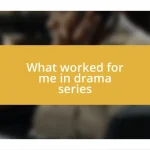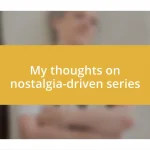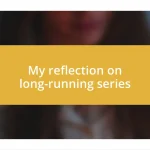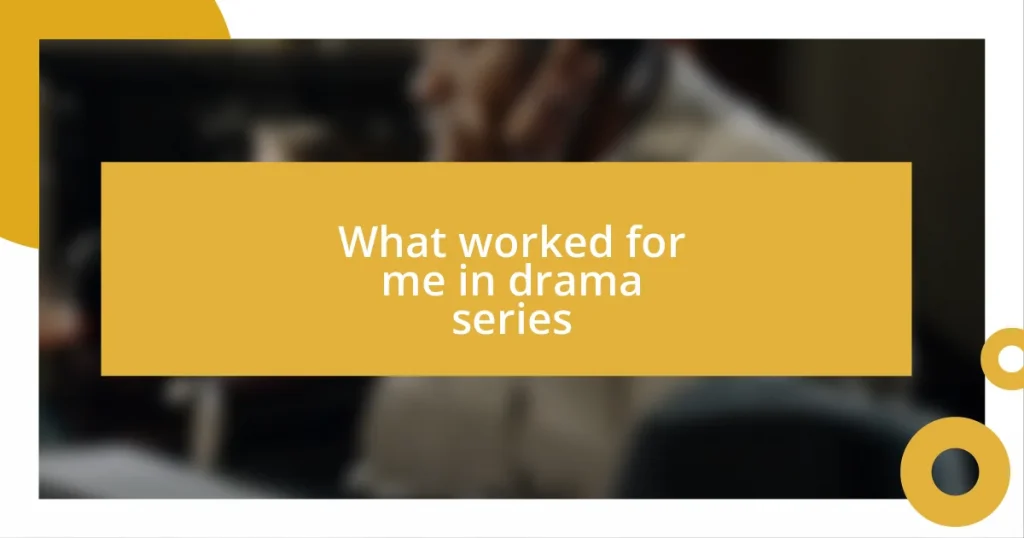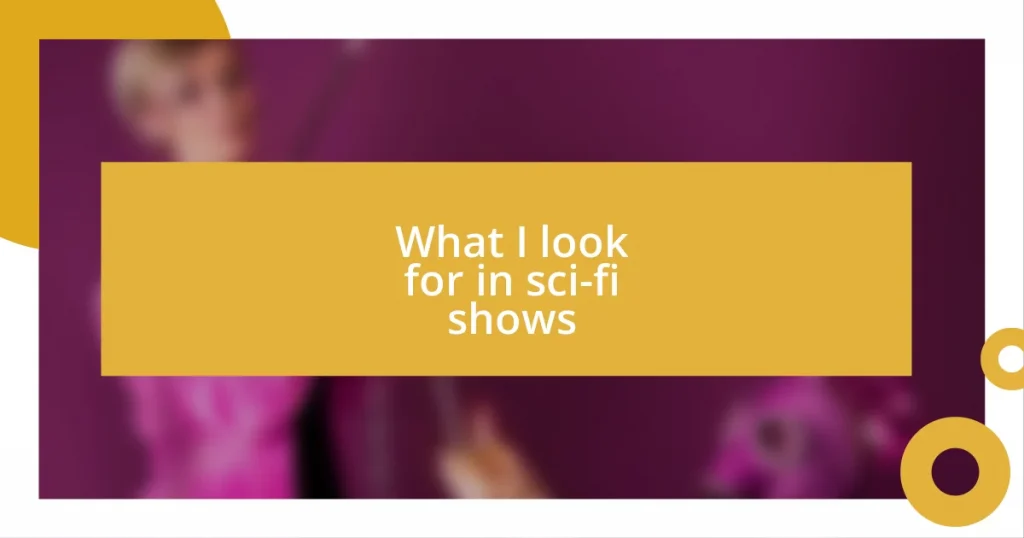Key takeaways:
- The Twilight Zone has significantly influenced modern storytelling through its twist endings, moral dilemmas, and rich character development, laying a foundation for shows like Black Mirror.
- The series effectively employs unique narrative techniques, such as unreliable narrators and cliffhanger endings, encouraging viewers to engage deeply with underlying themes and reflect on personal values.
- The show’s legacy is profound, resonating with contemporary societal issues and embedding itself in pop culture, inspiring countless creators and continuing to provoke thought and introspection on ethics and humanity.

Influence on modern storytelling
The influence of The Twilight Zone on modern storytelling is profound and undeniable. I often find myself amazed by how many contemporary series and films borrow from its signature twist endings and thought-provoking narratives. Isn’t it fascinating how that simple black-and-white anthology format paved the way for complex storytelling that challenges our perceptions?
Whenever I watch shows like Black Mirror or The Outer Limits, I can’t help but feel a sense of nostalgia. They capture that same eerie ambiance and ethical questioning that The Twilight Zone perfected. It’s as if I’m transported back to my childhood, eagerly anticipating the plot twist that would leave me both unsettled and reflective.
Reflecting on my own storytelling, I’ve learned to embrace the unexpected. The Twilight Zone taught me that a simple twist, followed by a moral inquiry, can elevate a narrative from mundane to memorable. Have you ever considered how a single episode could influence your approach to creativity? It reminds us that the art of storytelling is not just about entertainment, but also about sparking curiosity and inviting introspection.

Unique narrative techniques
One of the most striking narrative techniques used in The Twilight Zone is its clever framing of moral dilemmas. The episodes often place characters in situations where they must make life-altering decisions, forcing viewers to confront their own values. I remember watching “The Monsters Are Due on Maple Street” and being struck by how quickly paranoia spread among neighbors. It made me reflect on the fragility of trust within communities and challenged my understanding of human nature.
The use of unreliable narrators throughout the series also adds a compelling layer to the storytelling. In episodes like “Nightmare at 20,000 Feet,” I was pulled into the psyche of the protagonist, experiencing his anxiety firsthand while questioning what was real. This immersion into the character’s mind sparked a personal exploration of my own fears. Have you experienced a similar moment when a show brought your own anxieties to the forefront?
Another unique aspect is the masterful use of cliffhanger endings that leave lingering questions long after the credits roll. Each time I revisit an episode, I find new layers of meaning—and sometimes I even discover how they resonate with my life experiences. It’s one thing to create suspense, but The Twilight Zone did so while embedding deep philosophical questions that encourage watchers to ponder long after the episode ends.
| Narrative Technique | Description |
|---|---|
| Moral Dilemmas | Characters face choices that probe their ethics and reveal human nature. |
| Unreliable Narrators | Immersive storytelling through the subjective experience of characters. |
| Cliffhanger Endings | Suspenseful conclusions that provoke thought and reflection beyond the episode. |

Character development in episodes
One of the most remarkable elements of character development in The Twilight Zone is how it often shifts and evolves in such a limited timeframe. In just 25 to 30 minutes, characters transition from ordinary individuals to deeply complex figures grappling with extraordinary circumstances. I recall watching “A Stop at Willoughby,” where the protagonist, an overworked executive, seeks solace in a seemingly perfect town. His transformation—an escape from the hustle of life to a serene paradise—actually made me ponder my own desires for escape. Isn’t it interesting how a brief moment on screen can hold up a mirror to our own lives?
In each episode, we witness characters confronting their innermost fears and desires, revealing their true selves by the end. The character arcs, though brief, always felt profound to me, revealing layers of complexity that often defy expectations. Here are a few examples that highlight this growth:
- “Walking Distance”: A man returns to his childhood town, discovering the bittersweet nature of nostalgia and lost dreams.
- “It’s a Good Life”: A boy with godlike powers forces everyone to cater to his whims, exposing the darker side of unchecked authority.
- “The Eye of the Beholder”: A woman undergoes surgery to fit societal standards, challenging concepts of beauty and individuality.
Each character’s journey serves as a poignant reminder of our own struggles and aspirations, inviting viewers to connect on a more personal level.

Social commentary through allegory
The allegorical nature of The Twilight Zone serves as a powerful lens through which we can view societal issues. For instance, episodes like “The Obsolete Man” tackle themes of censorship and individuality in a chilling, dystopian setting. I remember feeling a chill run down my spine as I watched a bookish man on trial for his existence—how hauntingly relevant that feels in today’s age of cancel culture. Reflecting on these themes made me question how we value dissenting voices in our own society—don’t you think we could use more of that kind of introspection?
What truly resonates with me is how the show often crafts immediate parallels to contemporary societal struggles, using allegory to unpack complex human experiences. For example, “Eye of the Beholder” forced me to confront my prejudices about beauty and conformity. As I watched a woman undergo surgery to fit into society’s narrow definition of attraction, I couldn’t help but relate it to my own experiences feeling pressured to conform. Have you felt that societal pressure too? It brings to light how we’re still grappling with issues of self-acceptance and identity—issues that The Twilight Zone explored so fearlessly.
Moreover, the stories often encapsulate a moral lesson that urges viewers to reflect on their behavior and beliefs. In “The Monsters Are Due on Maple Street,” the darkness within humanity unfurls as neighbors turn on each other over fear of the unknown. I found myself thinking about how easily society can fall prey to suspicion. Have you noticed this happening in your own community? It’s a stark reminder that the shadows we fear may, in fact, be a reflection of ourselves.

Cinematic techniques and visuals
The use of cinematography in The Twilight Zone is truly captivating. The show’s creators masterfully employed shadows and lighting to create suspense and evoke emotion. I vividly remember watching “The Monsters Are Due on Maple Street” and feeling the tension build as the camera panned over the anxious faces of the neighbors, shadows flickering ominously—didn’t you feel a sense of dread too? Those visual cues significantly enhanced the narrative, making the psychological horror even more palpable.
More than just atmosphere, the choice of camera angles profoundly influenced the viewer’s experience. Close-ups often revealed characters’ emotions, drawing viewers into their internal struggles. I think about “The Eye of the Beholder,” where the woman’s face is obscured until the climactic moment. That reveal had me on edge—how could something so subtle deliver such an impactful message about societal standards? It’s these clever techniques that amplify the storytelling, turning a simple scene into a resonant experience.
Additionally, the show’s use of surreal imagery remains one of my favorite aspects. With its blend of stark realities and dreamlike visuals, it often felt like stepping into a painting filled with unsettling details. Episodes like “The After Hours” use props and settings to blur the lines between reality and illusion. I can still remember the eerie department store—was it a real place or just a figment of the protagonist’s imagination? This ambiguity invites viewers to question their own perceptions, making every episode an exploration into the uncanny. Isn’t that what makes watching The Twilight Zone such a thought-provoking journey?

Memorable episodes to explore
One unforgettable episode is “To Serve Man,” which has always left me torn between fascination and dread. The notion that an alien race could come to Earth with seemingly benevolent intentions—only for it to unearth a darker purpose—had me on the edge of my seat. I remember discussing it with friends afterward, analyzing how easily we could misinterpret true motives. Isn’t it unsettling to think that sometimes, appearances can be deceiving?
Then there’s “Living Doll,” which plays on the fears surrounding innocence turned sinister. The simple premise of a doll that seems to come to life is executed so meticulously that it lingers long after the credits roll. I recall peeking into my own child’s toy box after watching, half-expecting one of their toys to have a mind of its own! It really taps into that primal fear—how often do we overlook the simple things that can harbor unsettling surprises?
Finally, “The Hitch-Hiker” stands out for its atmospheric tension and psychological depth. The protagonist’s encounter with her relentless pursuer exemplifies how fear can manifest when one confronts mortality. I recall feeling a mix of empathy and anxiety as she desperately tried to outrun her fate. This episode resonates with anyone who has faced life’s uncertainty, don’t you think? It serves as a poignant reminder that sometimes, avoidance only heightens our fears.

Legacy and cultural significance
The cultural legacy of The Twilight Zone is both profound and far-reaching. Its blend of science fiction, psychological thriller, and moral lessons spoke to audiences in ways that resonate even today. I can’t help but recall how, during discussions in college, we often connected the show’s themes to contemporary social issues. Isn’t it fascinating how a program from the 1960s continues to spark conversations about ethics and humanity?
Notably, The Twilight Zone influenced countless filmmakers and writers, sparking a wave of storytelling that explored the boundaries of reality. I remember watching various modern shows and films that incorporate its narrative twists and existential questions. It made me realize that many contemporary creators pay homage to the intricate ways the series addressed societal fears and norms. In doing so, the show has become a benchmark for quality storytelling—an exemplar of the impact a single series can have on an entire genre.
Moreover, the program’s iconic opening narration and memorable phrases have embedded themselves in pop culture. It’s nearly impossible to hear “You unlock this door with the key of imagination” without feeling a rush of nostalgia. I often find myself quoting those lines during conversations, inviting others to explore their own fond memories. How many shows can claim such a lasting imprint on collective consciousness? The Twilight Zone brilliantly opened the door to endless possibilities, making it a staple of cultural significance that invites us to keep questioning and imagining.
